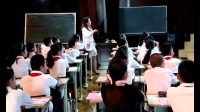視頻簡介:

視頻標(biāo)簽:基本功比賽
所屬欄目:小學(xué)英語優(yōu)質(zhì)課視頻
視頻課題:2016年全國小學(xué)英語教師基本功比賽冀教版五年級《What Are They
教學(xué)設(shè)計、課堂實錄及教案:2016年全國小學(xué)英語教師基本功比賽優(yōu)質(zhì)課視頻冀教版五年級《Unit 1 Lesson 5 What Are They Doing》河北馬雯彥
冀教版小學(xué)英語五年級下冊第一單元
Lesson 5 What Are They Doing?
1.整體設(shè)計思路,指導(dǎo)依據(jù)說明
本節(jié)課是冀教版小學(xué)英語五年級下冊第一單元Lesson 5 What Are They Doing? 本單元主要學(xué)習(xí)現(xiàn)在進行時態(tài)的表達(dá)方式。現(xiàn)在進行時與我們?nèi)粘=浑H息息相關(guān),本課是現(xiàn)在進行時的進一步學(xué)習(xí),是本單元的重要組成部分。讓學(xué)生在真實的情景中進行操練,培養(yǎng)學(xué)生主動學(xué)習(xí)英語的興趣和綜合語言運用能力。
2.教學(xué)背景分析
教學(xué)內(nèi)容分析:
本節(jié)課是第一單元第五課,本單元前四課都是圍繞現(xiàn)在進行時態(tài)展開的。本節(jié)課的情景是在火車上,李明,Jenny兩人聞聲談?wù)摶疖嚿系某丝驼谧龅氖虑椋徽勚邪l(fā)現(xiàn)Danny已不在他們的視線中,從而通過詢問Danny,解釋了李明最初想知道baby在做什么的問題。本課的主要學(xué)習(xí)內(nèi)容是學(xué)生能夠運用What are they doing? They are ...的句型引導(dǎo)學(xué)生正確使用現(xiàn)在進行時談?wù)撍苏谧龅膭幼鳌8鶕?jù)教學(xué)文本及現(xiàn)在進行時運用于談話中的特點,要求教師在教學(xué)中要避免明知故問的活動設(shè)計,因此在這一課的教學(xué)過程中,我采用多種方式引導(dǎo)學(xué)生能夠在特定情境中運用現(xiàn)在進行時,提高學(xué)生綜合語言應(yīng)用能力。
學(xué)生情況分析:
本節(jié)課的授課對象是小學(xué)五年級的學(xué)生,他們已具備了一定的英語口語表達(dá)能力和書寫能力。本單元前幾課都是圍繞現(xiàn)在進行時態(tài)展開,學(xué)生已經(jīng)基本掌握現(xiàn)在進行時的單數(shù)的表達(dá)方式。本節(jié)課,學(xué)生要學(xué)習(xí)現(xiàn)在進行時的復(fù)數(shù)的表達(dá)方式,能夠鞏固運用現(xiàn)在進行時談?wù)撍苏谧龅膭幼鳌1竟?jié)課內(nèi)容與現(xiàn)實生活息息相關(guān),讓學(xué)生能夠更好的參與教學(xué)。同時該年級的學(xué)生已經(jīng)初步具有了一定的語言提煉,歸納和總結(jié)能力,但是還有待加強和提高。
3.教學(xué)目標(biāo)
1. 學(xué)生通過課文學(xué)習(xí),能準(zhǔn)確運用現(xiàn)在進行時在情境中提問或描述他人正在做的事情。
2. 學(xué)生通過模仿,表演課文對話。
3. 學(xué)生通過虛擬生活情境,能夠運用現(xiàn)在進行時展開簡單的交流。
4.教學(xué)內(nèi)容:
1. 學(xué)習(xí) What are they doing ? They are … 并且鞏固運用What is he/she doing? He/She is…
2. 理解文本內(nèi)容并回答相應(yīng)問題。
3. 表演課文對話。
4. 排演生活片段。
5.教學(xué)重難點
教學(xué)重點:現(xiàn)在進行時復(fù)數(shù)表達(dá)形式
教學(xué)難點:在生活情境中正確使用現(xiàn)在進行時態(tài)
6.教學(xué)過程:
Step 1Preparation
A. Greeting
Hello, boys and girls. Nice to meet you. Let’s begin our English class.
B. Review
Brainstorming:
T: Boys and girls, keep your eyes open. I will show you six pictures, try your best to remember “What is she/he doing?” Let’s begin. (圖片出現(xiàn)后全部消失)
T: Who wants to try?
(設(shè)計意圖:通過頭腦風(fēng)暴的游戲,讓學(xué)生復(fù)習(xí)現(xiàn)在進行時態(tài)的單數(shù)形式)
Step2 Presentation
A: 新授句型 :用比較式教學(xué)法,由單數(shù)到復(fù)數(shù)教授句型What are they doing? They are…
T: What is the girl doing?
S1: She is running.
T: Maybe
S2: She is flying a kite.
TS: Look, she is flying a kite.
T: What is the boy doing?
S: He is flying a kite.
T: Yes.
T: What are they doing?
S: They are flying kites.
(設(shè)計意圖:此部分主要是通過圖片單復(fù)數(shù)的對比,由現(xiàn)在進行時的第三人稱,來過渡到新授句型現(xiàn)在進行時的復(fù)數(shù)形式 What are they doing?)
B:拓展 What are they/ the animals/the women/Lucy and Tom/… doing? )
T: What are they doing? / What are the animals doing?
S: They are running.
T: Maybe.
S: The animals are playing football in the park.
T: Yes.
T: Who can ask a qusetion?
S:What are they doing?
T: Yes. Any question?
S: What are the women doing?
T: Please guess.
S:They are…
T: Yes.
T: Can you ask a question?
S: What are Lucy and Tom doing?
T: Good. Guess.
S:They are…
T: Yes.
(設(shè)計意圖:此環(huán)節(jié)新授句型What are they doing? They are… 并且通過猜圖游戲練習(xí)鞏固此句型。)
C: Text
1. Pre-reading
T: Look, here are our friends. Danny, Jenny and Li Ming. But, where are they now? (播放火車音效)
Ss:They are on the train.
T: Let’s get on the train.
2. while-reading
T: Now, read and circle, who is on the train?
S1…
S2…
T: Read and underline “What are they doing?”
S1: The woman is reading the newspaper.
S2: Danny is playing with the baby.
S3: The man is playing cards with his friends.
S4: Jenny is looking for Danny.
T: What is Li Ming doing?
S: He is talking with Jenny.
…
(設(shè)計意圖:通過向?qū)W生提問 Who? What? 讓學(xué)生默讀的方式,讓學(xué)生自己提煉出課文的重點并且再次鞏固現(xiàn)在進行時。)
3. After-reading
T: Now,boys and girls ,it’s your turn .Listen and imitate. Three people make a group. Who wants to be Danny? Hands up! Li Ming, hands up! Jenny hands up!
T: Who wants to show?
S: 學(xué)生展示
(設(shè)計意圖:在學(xué)生理解文本的基礎(chǔ)上,聽文本,訓(xùn)練語音語調(diào)。同時分角色表演,加深學(xué)生對文本的理解。)
Step 3Practice
A: Turntable
T: I feel boring on the train. How about you? Let’s play a game. Look, It’s a turntable. Do you want to play? (找學(xué)生上來)Let’s ask a question together.
Ss: What are they doing?
S1: They are…
B: Guessing cards
T: You can ask and answer like this. (教師示范) Who can guess more, who is the winner.
T: Who is the winner? Can you show these pictures for us?(找學(xué)生描述自己的卡片,此環(huán)節(jié)注意糾正學(xué)生的錯誤)
(設(shè)計意圖:鞏固練習(xí)現(xiàn)在進行時,并且為后面的拓展環(huán)節(jié)做鋪墊)
Step 4 Production
T: How time flies? Boys and girls listen carefully. (播放火車到站的音效,說明我們已經(jīng)到達(dá)了公園)wow , the park is so beautiful, talk with your partner.
S: 學(xué)生展示
Step 5 Progress
A: Summarize
B: Homework
Today’s homework, choose a library, a store… to make your own story.
7.板書設(shè)計
Lesson5 What Are They Doing?
They are flying kites.
The woman read
What are they doing? The man play cards
Danny play with the baby
Li Ming and Jenny talk
8. 教學(xué)評價設(shè)計
本節(jié)課采用多種評價方式,學(xué)生互評、教師評價相結(jié)合,激發(fā)學(xué)生的學(xué)習(xí)興趣,有效地提高了課堂效率。
⑴ 教師口頭表揚。當(dāng)學(xué)生表現(xiàn)出色、克服困難、敢于開口以及學(xué)生課堂反應(yīng)等等情況下老師會給予及時的表揚,這種評價有助于學(xué)生大膽、正確的認(rèn)識自我。
⑵生生評價。整個學(xué)習(xí)過程,互相學(xué)習(xí),共同戰(zhàn)斗,建立合作意識,同時通過在競爭的過程中整體評價,刺激孩子們互助合作,共同進步的團隊意識。
視頻來源:優(yōu)質(zhì)課網(wǎng) www.jixiangsibao.com
| -----更多視頻請在本頁面頂部搜索欄輸入“基本功比賽”其中的單個詞或詞組,搜索以字?jǐn)?shù)為3-6之間的關(guān)鍵詞為宜,切記!注意不要輸入“科目或年級等文字”。本視頻標(biāo)題為“2016年全國小學(xué)英語教師基本功比賽冀教版五年級《What Are They”,所屬分類為“小學(xué)英語優(yōu)質(zhì)課視頻”,如果喜歡或者認(rèn)為本視頻“2016年全國小學(xué)英語教師基本功比賽冀教版五年級《What Are They”很給力,您可以一鍵點擊視頻下方的百度分享按鈕,以分享給更多的人觀看。優(yōu)質(zhì)課網(wǎng) 的成長和發(fā)展,離不開您的支持,感謝您的關(guān)注和支持!有問題請【點此聯(lián)系客服QQ:983228566】 ----- |
